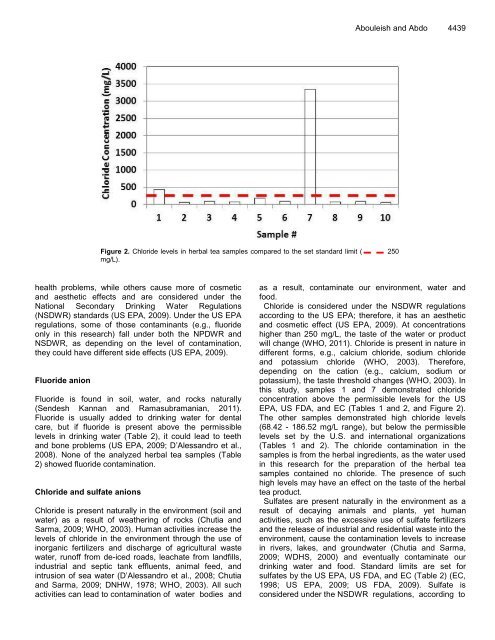Download Complete Issue (4740kb) - Academic Journals
Download Complete Issue (4740kb) - Academic Journals
Download Complete Issue (4740kb) - Academic Journals
You also want an ePaper? Increase the reach of your titles
YUMPU automatically turns print PDFs into web optimized ePapers that Google loves.
Figure 2. Chloride levels in herbal tea samples compared to the set standard limit ( 250<br />
mg/L).<br />
health problems, while others cause more of cosmetic<br />
and aesthetic effects and are considered under the<br />
National Secondary Drinking Water Regulations<br />
(NSDWR) standards (US EPA, 2009). Under the US EPA<br />
regulations, some of those contaminants (e.g., fluoride<br />
only in this research) fall under both the NPDWR and<br />
NSDWR, as depending on the level of contamination,<br />
they could have different side effects (US EPA, 2009).<br />
Fluoride anion<br />
Fluoride is found in soil, water, and rocks naturally<br />
(Sendesh Kannan and Ramasubramanian, 2011).<br />
Fluoride is usually added to drinking water for dental<br />
care, but if fluoride is present above the permissible<br />
levels in drinking water (Table 2), it could lead to teeth<br />
and bone problems (US EPA, 2009; D’Alessandro et al.,<br />
2008). None of the analyzed herbal tea samples (Table<br />
2) showed fluoride contamination.<br />
Chloride and sulfate anions<br />
Chloride is present naturally in the environment (soil and<br />
water) as a result of weathering of rocks (Chutia and<br />
Sarma, 2009; WHO, 2003). Human activities increase the<br />
levels of chloride in the environment through the use of<br />
inorganic fertilizers and discharge of agricultural waste<br />
water, runoff from de-iced roads, leachate from landfills,<br />
industrial and septic tank effluents, animal feed, and<br />
intrusion of sea water (D’Alessandro et al., 2008; Chutia<br />
and Sarma, 2009; DNHW, 1978; WHO, 2003). All such<br />
activities can lead to contamination of water bodies and<br />
Abouleish and Abdo 4439<br />
as a result, contaminate our environment, water and<br />
food.<br />
Chloride is considered under the NSDWR regulations<br />
according to the US EPA; therefore, it has an aesthetic<br />
and cosmetic effect (US EPA, 2009). At concentrations<br />
higher than 250 mg/L, the taste of the water or product<br />
will change (WHO, 2011). Chloride is present in nature in<br />
different forms, e.g., calcium chloride, sodium chloride<br />
and potassium chloride (WHO, 2003). Therefore,<br />
depending on the cation (e.g., calcium, sodium or<br />
potassium), the taste threshold changes (WHO, 2003). In<br />
this study, samples 1 and 7 demonstrated chloride<br />
concentration above the permissible levels for the US<br />
EPA, US FDA, and EC (Tables 1 and 2, and Figure 2).<br />
The other samples demonstrated high chloride levels<br />
(68.42 - 186.52 mg/L range), but below the permissible<br />
levels set by the U.S. and international organizations<br />
(Tables 1 and 2). The chloride contamination in the<br />
samples is from the herbal ingredients, as the water used<br />
in this research for the preparation of the herbal tea<br />
samples contained no chloride. The presence of such<br />
high levels may have an effect on the taste of the herbal<br />
tea product.<br />
Sulfates are present naturally in the environment as a<br />
result of decaying animals and plants, yet human<br />
activities, such as the excessive use of sulfate fertilizers<br />
and the release of industrial and residential waste into the<br />
environment, cause the contamination levels to increase<br />
in rivers, lakes, and groundwater (Chutia and Sarma,<br />
2009; WDHS, 2000) and eventually contaminate our<br />
drinking water and food. Standard limits are set for<br />
sulfates by the US EPA, US FDA, and EC (Table 2) (EC,<br />
1998; US EPA, 2009; US FDA, 2009). Sulfate is<br />
considered under the NSDWR regulations, according to

















